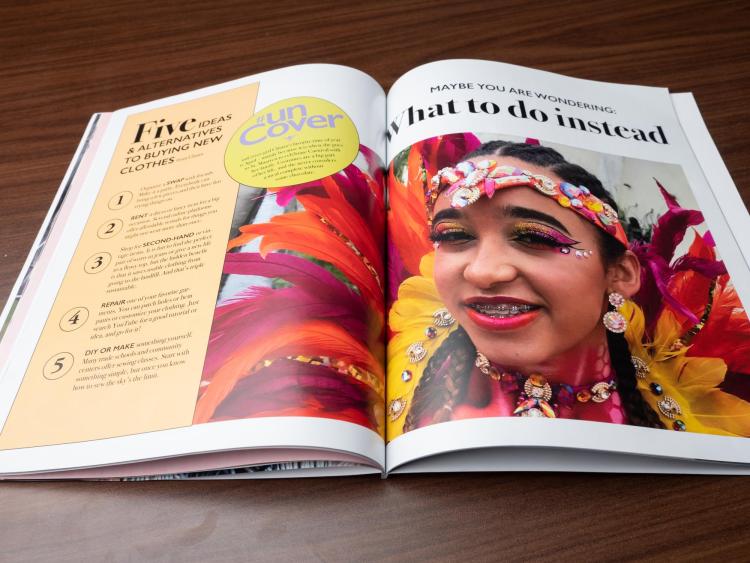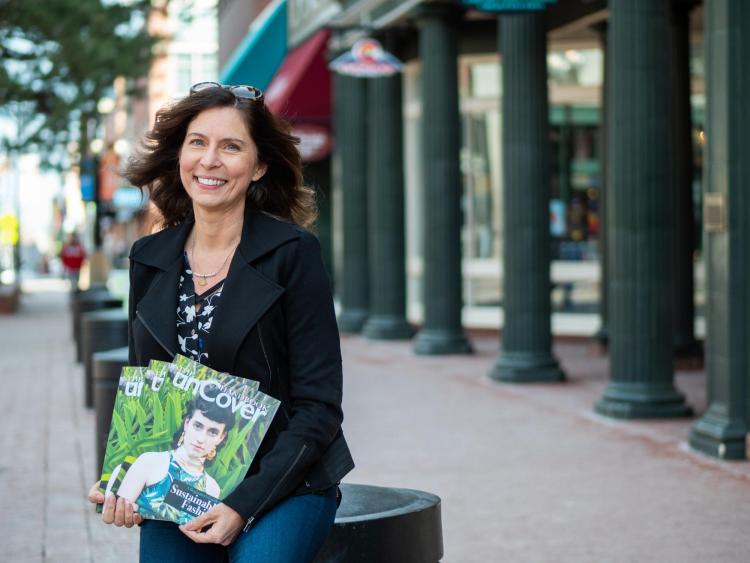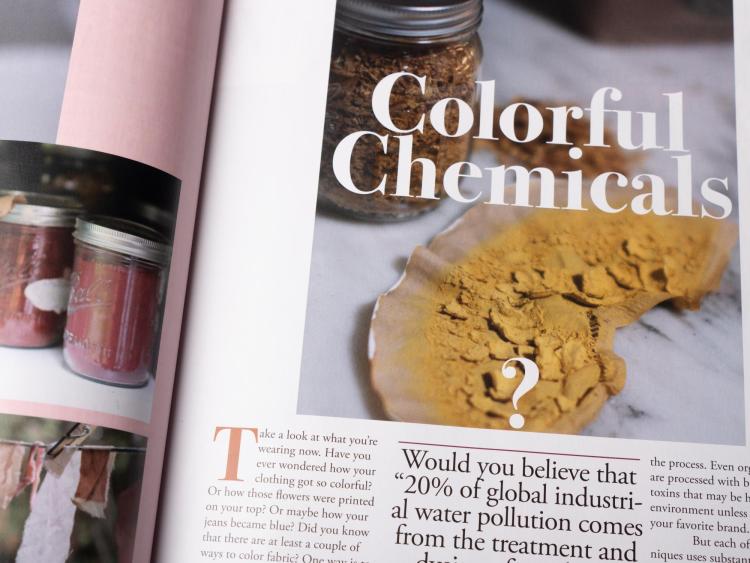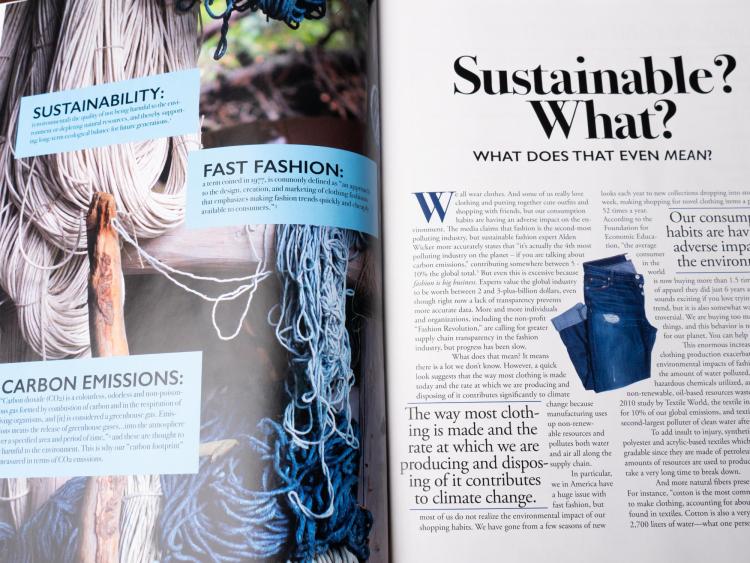Pushing Boundaries: Student’s fashion blog, magazine add sustainability to style

Graduate student Ana Bogusky’s passion for fashion inspired her to launch a style blog where she shares her ideas and outfits styled from clothing and accessories made only in America. Her blog Mrs. American Made is not just about her wardrobe; it also serves as a voice for creating awareness for shopping locally and ethically.
A desire to learn more about the environmental and humanitarian impact of how clothing is made in developing countries led Bogusky to enroll in the CU Boulder Masters of the Environment (MENV) graduate program.

Graduate student Ana Bogusky. Photo by Patrick Campbell / University of Colorado Boulder.
As she began paying more attention to labels, Bogusky saw that most clothing is made in China, Thailand, Cambodia, Indonesia and Turkey. After digging deeper to learn about how clothes are made, she learned only 2 percent of the clothing sold in the U.S. is made in this country.
The more she learned about the negative effects of how clothing is made, her perspective, and the mission of her blog, changed. For the past seven years, Bogusky has advocated a more sustainable and ethical approach to her wardrobe through her blog.
“My blog is focused on made-in-America clothes,” she said. “When I learned we’re sending all our production to China and other countries, I wanted to know how we can bring that back. I thought this blog was the best way for me to do that.”
After Bogusky, her husband and two children (now teenagers) moved from Miami, Florida, to Boulder in 2006, they became more mindful of their impact on the environment. They started eating more healthfully, buying locally grown produce and reading labels on food packages. Reading food labels evolved into reading clothing labels.
We love our retail therapy, but what it comes down to is that we’re creating a giant mess. Between 70 and 80 pounds of textile waste per person goes straight to landfills every year. Only one-fifth of donations are resold as clothing. The production of our clothing has an impact on the environment every step of the way.”
Her path to graduate school began when she was asked to teach a workshop at her daughter’s high school in Boulder. Bogusky didn’t feel credentialed enough to present material on fashion sustainability, so she searched for an online fashion certification course. After earning the online certificate, Bogusky, who has a BA in mathematics and art from Duke University, realized she wanted a graduate degree. Another online search led her to CU Boulder and MENV’s sustainable food systems specialization.
“While this specialty is not fashion-specific, it is a big picture of sustainability,” she said. “It’s the context for how all of this consumption fits. I needed to know all of that in order be able to explain the rest of it. As I learned more, I decided it was better to buy less, period.”
For her capstone project, Bogusky designed and produced an online and print publication called The unCover Handbook to help consumers make educated choices when shopping. Bogusky doesn’t preach but presents facts from painstaking research.
The magazine-like handbook she calls a “beginner’s guide to sustainable fashion” is filled with easy-to-understand information, data, and colorful graphics and photos. Topics include sustainable clothing care; the environmental and humanitarian effects of making clothing; waste and recycling; and what to look for on clothing labels.
Take a peek inside


Her suggested alternatives to buying new clothes include shopping for second-hand clothes, swapping with friends, DIY projects and tips for putting together stylish outfits from clothes bought at secondhand stores.
“It’s a hard subject to study, because there’s a lot of dismal news about fashion,” said Bogusky, who is the only MENV student focusing on sustainable fashion. “All these pretty things to buy. We love our retail therapy, but what it comes down to is that we’re creating a giant mess. Between 70 and 80 pounds of textile waste per person goes straight to landfills every year. Only one-fifth of donations are resold as clothing. The production of our clothing has an impact on the environment every step of the way.”
Nicole Civita, lead for sustainable food systems, one of four specializations in the MENV program, said Bogusky has created a foundation for all ages to cultivate a new consciousness for consumption.
While there is no formal MENV specialization for sustainable fashion systems, with help from faculty advisors Bogusky found parallels in sustainable food systems, which isn’t as far-fetched as it may sound. As with food, much of clothing is derived from various forms of agriculture, such as cotton and flax, or animal-based fibers like wool and leather.
Food and fashion are both consumables. We have fast food, and with the advent of fast fashion—a term based on the idea of fast food—there are increasing fast consumption cycles in apparel, as well.
“Ana has come at this as someone who genuinely appreciates fashion and not someone who denigrates it for all the ills it causes,” Civita said. “She takes great care and pride in expressing herself through her clothing. She’s added on top of that a layer of making sure she feels good about what she’s doing to look good. What comes through in this piece of work is the joy she brings.”
The MENV curriculum has a core set of required classes, required courses in a student’s specialization and an additional set of elective credits. Civita works with Bogusky to identify master’s-level courses at the university where she can subspecialize in her interest area through electives.
“We do a lot of minor modifying in classes to make sure that when there’s a project, she can focus it in a way that also feeds her interest in fiber,” Civita said.


